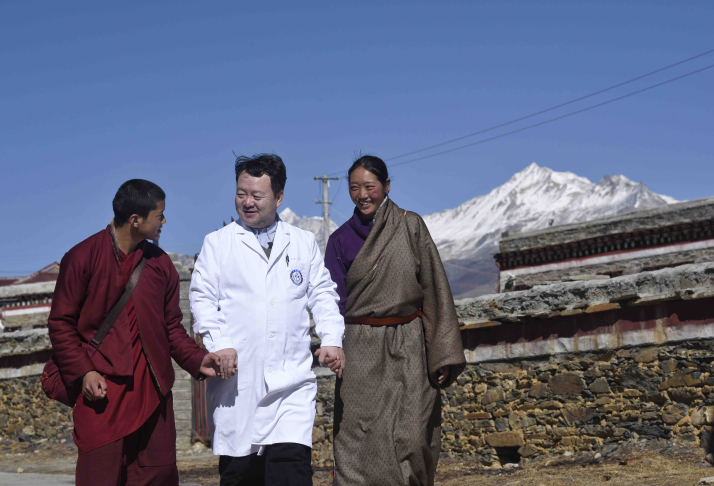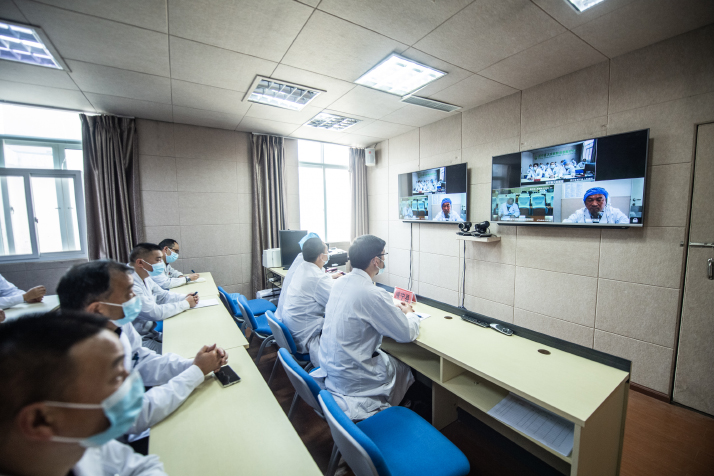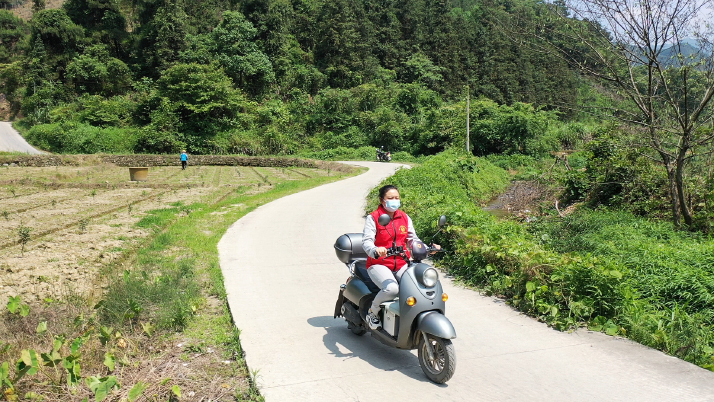| China |
| Rural healthcare has made headway over the past decade | |
|
|
 Wang Wentao (center), a doctor from West China Hospital, Sichuan University in Chengdu, Sichuan Province, revisits his patients who have recovered from hydatid disease in Garze Tibetan Autonomous Prefecture in the province on January 17, 2020 (XINHUA)
Linquan, a county in Fuyang, Anhui Province, rose out of poverty in April 2020. The county has a large number of cancer patients but, in the past, had no oncology department. Patients had to travel to larger cities for treatment, which increased the overall expenses. However, the situation has changed thanks to a paired assistance program, which started in 2016.
Under the program, Peking University First Hospital in Beijing sent cancer experts to help the county establish its own oncology department at Linquan People's Hospital. Today the hospital in the county has mastered multiple cancer treatment technologies and is able to carry out the treatments independently. Since 2016, Peking University First Hospital has provided paired assistance to many county-level hospitals, including Linquan People's Hospital, Lankao Central Hospital in Henan Province, and Yonghe People's Hospital in Shanxi Province. More than 300 experts have been sent to these three hospitals to help them master 150 kinds of new technologies and conduct more than 2,000 surgeries, Jiang Hui, Secretary of the Communist Party of China (CPC) Committee of Peking University First Hospital, said at a press conference on the improvement of healthcare in rural areas in the past decade, held by the National Health Commission (NHC) on May 24. "For instance, we helped Yonghe People's Hospital to establish a dialysis center in 2020. Five machines for dialysis are able to work at the same time, providing great convenience for local patients," Jiang said. Paired assistance is one of the measures China has taken to improve medical care in rural areas. Rural medical care is important for the health of rural residents and therefore an important part of rural revitalization. Since the 18th CPC National Congress in 2012, the NHC has prioritized rural areas in its healthcare work and rural healthcare has made headway. He Jinguo, Director of the Department of Finance of the NHC and head of the commission's Rural Revitalization Office, said health is the foundation of poverty alleviation and common prosperity. Since the 18th CPC National Congress, the NHC has worked to ensure basic medical care for impoverished rural people and has helped nearly 10 million families who have plunged into or returned to poverty because of illness. China has filled the gap in rural medical care institutions and staff, enabling rural residents to have equal access to basic medical services. Now, rural residents are able to receive timely treatment for common and chronic diseases. The competence of hospitals in counties that have recently risen out of poverty has improved greatly, which has further helped narrow the gap in medical services between urban and rural areas. Efforts have been made to enable every county which has climbed out of poverty to have at least one public hospital. Additionally, the median number of diseases treatable at these hospitals has reached 90 percent of the average for all county-level hospitals in China. An increasing number of major diseases can now be treated effectively at county-level hospitals. Prevention and control of major diseases have achieved historic results. Major diseases that have long affected people's health including HIV/AIDS and echinococcosis or hydatid disease—a parasitic illness caused by liver tapeworms that is common among herders who roam China's northwestern regions—are now under control, laying a foundation for building a healthy China.  A remote consultation is held between doctors of the Weining Yi, Hui and Miao Autonomous County People's Hospital in Bijie, Guizhou Province, and experts from Guizhou Provincial People's Hospital in Guiyang, capital of Guizhou, on March 29 (XINHUA)
Ample supplies Medical supplies in impoverished areas have been increased to satisfy people's demand for medical services. He said expenditure on medical care in impoverished regions has been continuously increased in recent years. From 2015 to 2020, the Central Government spent 1.4 trillion yuan ($209.7 billion) to support the development of medical care in 25 provincial-level regions with relatively large impoverished populations, with expenditure growing 11.6 percent on average each year. Policies regarding the training and recruitment of medical professionals have been adjusted to support medical development in rural areas. Age and diploma requirements in the recruitment of medical professionals for county-level medical institutions or below in impoverished and remote regions have been relaxed to expand the medical talent pool. A program for recruiting general practitioners for township hospitals has been implemented, under which over 3,000 general practitioners have been recruited. According to a notice published by the State Council in June last year, medical graduates are allowed to apply for a village doctor practicing license without having to take an exam, which will help increase their numbers and improve the overall competence of village doctors with more college graduates joining them. The nation's premium resources are being channeled into grassroots hospitals. Over 1,000 urban public hospitals have formed paired assistance relationships with 1,172 hospitals in impoverished counties. Under the program, 118,000 medical workers have been sent to work and provide guidance in county-level hospitals. Remote medical care has covered all impoverished counties and been extended to township hospitals. Through remote medical care, rural residents can have their checkups done at county-level hospitals and get a diagnosis from experts at higher-level hospitals.  Wang Xuedan, a doctor in Aimian Village, Rongan County, Guangxi Zhuang Autonomous Region, rides an electric scooter to visit patients on May 18 (XINHUA)
Medical institutions Progress has been made on the development of medical institutions in rural areas. The medical service network in rural areas has been improved, making it more convenient for residents to receive medical treatment near their homes. A 15-minute medical service circle whereby patients can arrive at a medical institution within 15 minutes of walking has been formed. As of late last year, there were 23,000 county-level medical institutions, 35,000 township hospitals and 599,000 village clinics nationwide. Township and village medical institutions have been guided to improve their service abilities, with over 90 percent of patients having received treatment in their own counties. Medical service models have also been innovated and the variety of services expanded to protect people's health. Family doctor services have been available across the country since 2016. As of late 2021, there were 1.435 million family doctors in China, providing residents with basic medical care and health management services. Family doctors have helped shift the focus of medical care services from disease treatment to health management. Rural residents can receive 12 categories of basic medical services, including vaccination and hypertension and diabetes management, at medical institutions at their place of permanent residence. A dynamic health management system for those living in poverty has been established by the NHC. "Through the system, we found that 10 million rural households have been plunged into or returned to poverty because of illness, accounting for 40 percent of all impoverished rural households. The figure underscores the importance of health in poverty alleviation," Zhang Xuying, Deputy Director of the China Population and Development Research Center, said at the press conference. Zhang said the system can now accurately diagnose diseases in rural households. "We have organized 800,000 medical workers in rural areas to visit rural families and learn about family members' illnesses, which had previously been registered in the dynamic health management system," Zhang said. We have used the information system for the more targeted treatment of illnesses. Over the years, targeted treatment has been offered to 2.9 million households with family members who have major diseases. Chronic disease management has been provided to 12.16 million households which have sunk into poverty because of chronic diseases. Health education has been offered to impoverished rural households, increasing health literacy in rural areas from 10.64 percent in 2017 to 20.02 percent in 2020. The NHC has collaborated with the National Healthcare Security Administration and the National Rural Revitalization Administration (NRRA) to guide local authorities to learn about the health conditions and medical insurance of people susceptible of sinking into or returning to poverty so as to achieve early detection, warning and assistance and prevent high numbers of returns to poverty due to illness. According to He, the monitoring and assistance system is proven to be effective. For instance, a senior citizen surnamed Ma who lives alone in Fuping, a county in Hebei Province, was diagnosed with kidney disease last June and needed dialysis treatment. She had no idea of where to get the treatment and she had difficulties paying for it. "We found out about her problem through our investigations and provided her with assistance in receiving treatment," He said. More to be done Healthcare assistance will continue to be provided to areas which have risen out of poverty. He said although some counties have shed poverty, they remain the weak links in regional development as they have unfavorable natural conditions and lack the ability to drive their own development. Last year, the Office of the Central Rural Work Leading Group and the NRRA designated 160 counties across 10 provinces, autonomous regions and municipalities in west China as key targets for assistance during the rural revitalization drive. He said the policies, funds and programs for supporting the development of healthcare in areas which have climbed out of poverty will remain stable and tilt toward the 160 counties. Paired assistance by large public hospitals in cities to county-level hospitals will continue. Prevention and treatment of major diseases, such as HIV/AIDS in Liangshan Yi Autonomous Prefecture in Sichuan Province and tuberculosis in Xinjiang Uygur Autonomous Region, will continue to be pushed ahead. Health promotion campaigns will be carried out in areas that have moved out of poverty, to popularize health knowledge and guide residents to exercise and have a more balanced diet. (Print Edition Title: Progress Across the Board) Copyedited by G.P. Wilson Comments to jijing@cicgamericas.com |
|
||||||||||||||||||||||||||||
|
